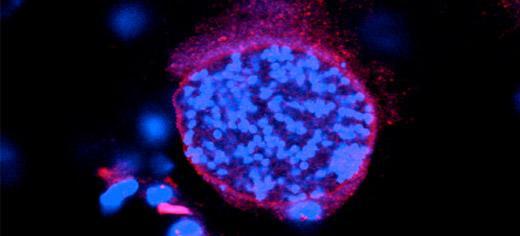
大脑包囊(图片来源:利兹大学)
研究显示,在英国有10-20%的人感染了大脑寄生虫刚地弓形虫(Toxoplasma gondii),这直接影响了大脑中化学信使多巴胺的产生。
来自英国利兹大学的研究发现首次证实,哺乳动物大脑中感染寄生虫会影响多巴胺的水平。
这项研究同时还在啮齿动物中开展过,领导这项研究的Glenn McConkey博士相信,这些研究发现可最终给治疗与多巴胺有关的人类神经性疾病(如精神分裂症、注意缺陷障碍、以及帕金森症)带来新的曙光。
这项研究成果引人注目,可以解释这些寄生虫是如何操控啮齿动物的行为为己所用。被寄生的小鼠和大鼠失去了对猫的本能恐惧感,提高了被抓住吃掉的可能性,使其可以返回其主要的宿主以完成生命周期。
在这项由斯坦利研究所和Dunhill医学基金资助的研究中,研究团队发现寄生虫导致了宿主大脑中产生和释放几倍于常量的多巴胺。
多巴胺是一种天然化学物质,其在大脑中传递信息以控制运动方向、认知及行为。它帮助控制大脑的奖励及快感中心,并调节诸如恐惧的情绪反应。某种特定的多巴胺受体也与感觉寻求有关,相反人类多巴胺的不足会导致帕金森症。
这些发现是以McConkey团队的早期研究为基础的,他们之前发现寄生虫实际上在其基因组中编码产生多巴胺的酶类。
“基于这些分析,很明显T. gondii 可以精心策划使得神经细胞中多巴胺的产量明显增高,” McConkey博士说。
“人类是T. gondii 的偶见宿主,寄生虫能在大脑的任何部位出现,因此人类的弓形虫感染症状可能与寄生虫出现的部位有关。这也许可以解释所观察到的精神分裂症发病率与弓形虫感染之间的数据关联。”
McConkey说他的下一步实验将观察寄生虫的酶如何触发多巴胺的产生以及这如何改变行为。
弓形虫病主要通过猫的粪便(在未清洗的蔬菜中有发现)以及生的或者未完全煮熟的感染过的肉传播,这种疾病相对普遍,估计在英国有10-20%的人群、美国22%的人携带了这种寄生虫的包囊。许多感染者身体健康,但是对那些免疫力不足尤其是怀孕的妇女来说,因感染而带来的健康风险相当高,有时甚至是致命的。
该类寄生虫通过在细胞中形成包囊而感染大脑,并产生生成多巴胺所必须的酪氨酸羟化酶。多巴胺在情绪、社交、注意力、运动及睡眠模式中的作用已有详细叙述,一直被认为与精神分裂症有关,是目前市面上所有精神分裂症治疗药物的目标。
酪氨酸羟化酶是生成L-DOPA(帕金森症中所描述的左旋多巴)的关键步骤,L-DOPA会转变为神经传递素多巴胺。

The Neurotropic Parasite Toxoplasma Gondii Increases Dopamine Metabolism
The highly prevalent parasite Toxoplasma gondii manipulates its host's behavior. In infected rodents, the behavioral changes increase the likelihood that the parasite will be transmitted back to its definitive cat host, an essential step in completion of the parasite's life cycle. The mechanism(s) responsible for behavioral changes in the host is unknown but two lines of published evidence suggest that the parasite alters neurotransmitter signal transduction: the disruption of the parasite-induced behavioral changes with medications used to treat psychiatric disease (specifically dopamine antagonists) and identification of a tyrosine hydroxylase encoded in the parasite genome. In this study, infection of mammalian dopaminergic cells with T. gondii enhanced the levels of K+-induced release of dopamine several-fold, with a direct correlation between the number of infected cells and the quantity of dopamine released. Immunostaining brain sections of infected mice with dopamine antibody showed intense staining of encysted parasites. Based on these analyses, T. gondii orchestrates a significant increase in dopamine metabolism in neural cells. Tyrosine hydroxylase, the rate-limiting enzyme for dopamine synthesis, was also found in intracellular tissue cysts in brain tissue with antibodies specific for the parasite-encoded tyrosine hydroxylase. These observations provide a mechanism for parasite-induced behavioral changes. The observed effects on dopamine metabolism could also be relevant in interpreting reports of psychobehavioral changes in toxoplasmosis-infected humans.
文献链接:https://www.plosone.org/article/info%3Adoi%2F10.1371%2Fjournal.pone.0023866







